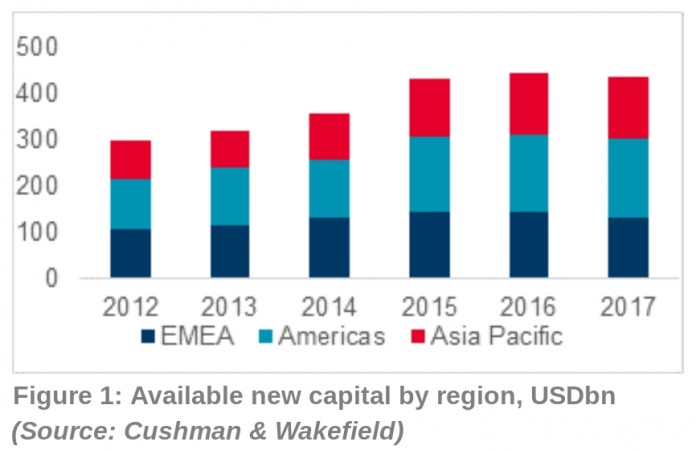The amount of new capital available for global real estate investment in 2017 stands at $435bn – a small drop on last year’s peak but the second-highest figure recorded since 2009, according to research from Cushman & Wakefield.
The Great Wall of Money report series tracks the amount of newly-raised capital, including debt and equity, targeting real estate at a global level. The total global wall of money has fallen by 2% compared with 2016, the first drop since 2011. However, current levels are the second highest on record, reflecting the extraordinary rise in capital targeting the sector this cycle.
Capital targeting EMEA shrunk 9% in US dollar terms to $130bn, whilst the Americas grew 2% to $173bn and Asia posted a marginal increase to $132bn.
Elisabeth Troni, Head of EMEA Research & Insight, Cushman & Wakefield, said: “With the great wall of money targeting real estate at near record levels, investors need to remain focused but agile. We expect 2017 to be marked by ongoing competition to place capital and source attractive opportunities. While core real estate strategies remain highly attractive, demand tends to outstrip supply in many key markets, pushing down yields and challenging investors. Unable to find enough existing core assets, investors are engaging in ‘build to core’ strategies targeting development or redevelopment projects that create core assets in top markets. In addition to new investment strategies, we expect new sources of capital to be unlocked around the world with countries such as China, Malaysia, Taiwan and South Africa to the fore.”
Target markets
Increasingly investors are concentrating on single country strategies rather than deploying capital across multiple borders. Single country investments now represent 61% of available capital, up 55% over the last three years. Based on Cushman & Wakefield estimations, the US is likely to remain the most targeted investment market in 2017. Although investment activity slowed during 2016, the great wall of money targeting the market remains high, with many investors still under allocated to the sector with regards to investment intentions.
China is expected to remain the second most targeted country with a majority of capital committed from domestic funds. There are a number of overseas funds seeking a foothold in China as rapid economic development provides a growing investment base, including a number of US domiciled funds.
The UK is the third most attractive market, albeit Cushman & Wakefield expects relatively less capital to target the UK as some investors take a ‘wait and see’ approach against the uncertain political and economic backdrop of Brexit negotiations. That said, some investors are keenly waiting on the side lines for more product to come to market in the event of pricing weakness.
Germany also continues to see strong levels of demand from investors attracted to its strong economic performance and relative ‘safe haven’ status and could benefit from some capital being diverted away from the UK. The challenge, especially for core funds, is accessing suitably-priced stock.
US trumps EMEA for most available equity
For the first time, more equity is available across the Americas ($79bn) than EMEA ($72bn). The wall of capital targeting the US has been building steadily as institutional investors have bumped up their allocations to the highest levels in history, and offshore investors swarm to park money in high-quality US assets. The fall in available equity across EMEA is largely a reflection of a strong dollar. With close to 80% of funds targeting Europe reporting in either euros or pounds, the currency context of reported volumes is a key component. Reflecting growing investor demand, Asia Pacific registered a strong 7% rise in available equity to $65bn.
Nigel Almond, Head of EMEA Capital Markets Research, said: “One of the most striking trends in commercial real estate is the growth in capital targeting Asia Pacific. For the first time we see more capital targeting Asia than EMEA, putting it second to the Americas, reflecting the maturity and growth of opportunities across the region as well as the prospects for attractive returns.





















